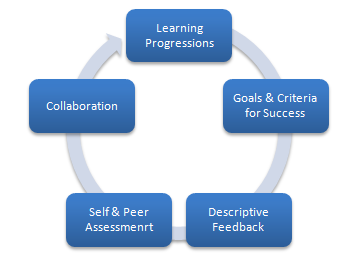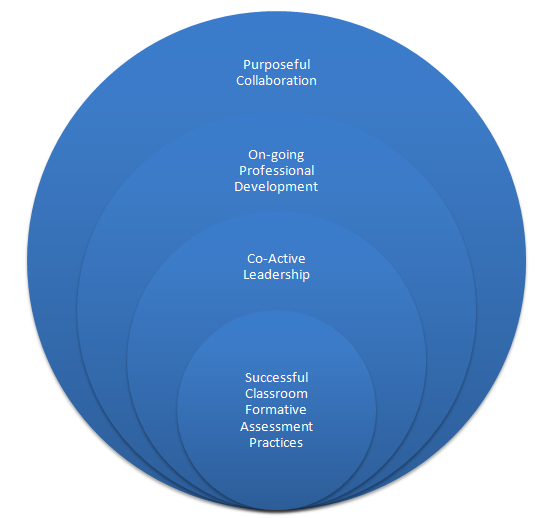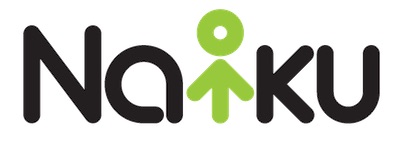What It Is and What Classroom & Schoolwide Practices Ensure Its Success
For the next three blogs I am going to focus on formative assessment. Why this focus?
Simple. A significant body of research has concluded that student-learning gains garnered by classroom formative assessment practices were among the largest ever reported for educational interventions (e.g., Black and Wiliam, 1998).
So, what exactly is formative assessment, how does it benefit what goes on in the classroom, what are its attributes, and what classroom- and schoolwide practices need to be in place to ensure its success?
What Is Formative Assessment and How Does it Benefit What Goes on in the Classroom?
In 2007, The Council of Chief State School Officers published what has now become an internationally cited definition of formative assessment:
- Formative assessment is a process used by teachers and students during instruction that provides feedback to adjust ongoing teaching and learning to improve students’ achievement of intended instructional outcomes.
Implied in this definition is a fundamental change in the relationship between students and teachers. Within a formative classroom environment, students and teachers become partners in learning.
In what ways do teachers and students benefit from this partnership, this change in their traditional classroom relationship?
The consequences of this partnership are powerful and impact the focus and quality of instruction and learning. In fact, the effective practice of classroom formative assessment improves instruction and learning in several specific ways:
- Teachers have greater access to important information about student learning;
- Teachers are better able to know what their students know and do not know;
- Teachers are better able to adjust their instruction to meet each student’s learning needs;
- Students become more engaged in their own learning;
- Students are better able to understand where they are in their learning;
- Students become active partners in the learning process; and
- The overall communication between students and teachers improves dramatically.
Formative Assessment Attributes & Classroom-level Practices
The following are five attributes of formative assessment and classroom-level practices that help to support and ensure its effective practice in the classroom (Wylie, 2008):
- Learning Progressions: These should clearly articulate the sub-goals of each standards-based learning goal so that both students and teachers understand what this progression looks like at each step of the way;
- Learning Goals and Criteria for Success: These should be clearly identified and communicated to students in ways that they understand. Students need to know exactly what success looks like for all the work they do in the classroom;
- Descriptive Feedback: Students should be provided with evidence-based, actionable feedback that helps them 1) better understand their own learning and 2) take effective steps to improve their learning;
- Self and Peer Assessment: These are important because they help students to think meta-cognitively about and take responsibility for their own learning; and
- Collaboration: It is important that educators create a schoolwide and classroom-level learning culture in which teachers and students are partners in learning.
These formative assessment attributes and classroom practices are connected and form an integrated process involving students and teachers.
And they don’t materialize out of thin air. They are intentional and require support, professional development, student participation and learning, on-going reflection/evaluation, and adjustment in order to be effective and sustain.
Schoolwide Practices
While formative assessment is embedded in classroom instructional practices, I think it’s important to shed some light on some of the schoolwide practices that support it and help make it successful for every teacher and each student.
All too often, teachers are isolated in their practice yet impacted both positively and negatively by the broader contextual circumstances of the school, district, and community.
For this reason, I end this blog with a brief description of some schoolwide practices that can help to dissolve this isolation, improve instructional practices, and enhance student participation and learning in the classroom.
While there are many schoolwide practices that can support formative assessment practices in the classroom, I want to briefly describe the following three.
Purposeful Collaboration: Maintaining successful collaboration between schools, districts, parents, and stakeholders in broader community
Ongoing, Job-embedded Professional Development: Creating a school-and district-wide learning culture through learning communities focused on the instructional core of the school—i.e., What goes on in the classroom. Click here for my blog post on this topic.
Co-Active Leadership: Building capacity for administrators, teachers, students, parents, and community stakeholders to help create and participate in the success of the school and to work together to improve their effectiveness individually and collectively. Click here for my blog post on this topic.

Earlier in this blog, I referenced an article by E. Caroline Wylie in my discussion of the five attributes of formative assessment. You might want to check out the article because it provides several classroom examples of what formative assessment is and what it is not.
You can find more on formative assessment by visiting our formative assessment page.

